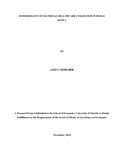| dc.description.abstract | World Health Organization approximates that every year about 210 million women conceive;
approximately 30 million develop complications; and 515,000 die. In addition, 3 million babies
are still born while 3 million die in the first week of life and many more bear different levels of
disability (WHO, 2010). KDHS 2008 shows that in Kenya, more women are dying of pregnancy
and childbirth related causes than was the case in 2003. In 2008, reported maternal deaths were
488 per 100,000 live births compared to 412 per 100,000 live births reported in 2003. Utilization
of maternal healthcare services is low in rural areas compared to urban areas (KDHS, 2008).
This study therefore sought to explore factors influencing utilization of maternal health care
services among the rural women in Kenya using the data from KDHS, 2008 with the key
objective of making policy recommendations to the government. The study used the binary
probit model to estimate the utilization of antenatal care, hospital delivery and postnatal care
services by rural women in Kenya.
Education levels, gender of household head, wealth index, marital status and employment status
significantly affect usage of antenatal care services as per the study findings. Hospital delivery is
significantly influenced by age, household size, birth order, education levels, religion, wealth
index, employment status and mass media. Gender of household head, religion, wealth index,
marital status and employment status significantly affect postnatal care. It is recommended
therefore that, the government comes up with policies which tend to improve utilization of
maternal health care utilization. For instance, for free maternal health care to be successful, the
government may want to ensure that all rural women can access healthcare facilities by bringing
the facilities closer to the people or by ensuring passable roads in all the rural areas. | en_US |

